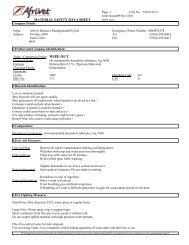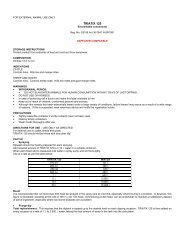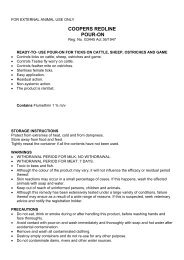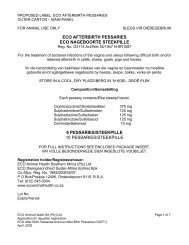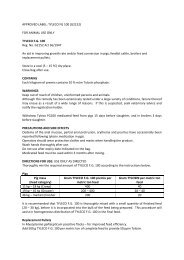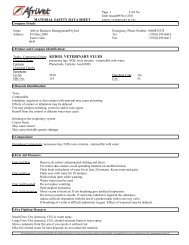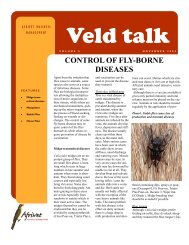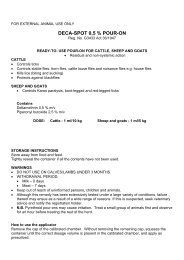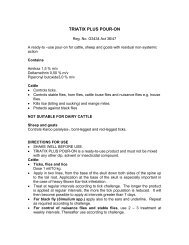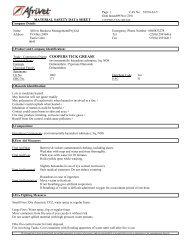Tick borne diseases and their control.pdf - Afrivet
Tick borne diseases and their control.pdf - Afrivet
Tick borne diseases and their control.pdf - Afrivet
You also want an ePaper? Increase the reach of your titles
YUMPU automatically turns print PDFs into web optimized ePapers that Google loves.
AFRIVET BUSINESS<br />
MANAGEMENT<br />
Veld talk<br />
FEATURES<br />
• Heartwater<br />
• Redwater<br />
• Anaplasmosis<br />
• Treatment<br />
V O L U M E 2<br />
TICK BORNE DISEASES AND<br />
THEIR CONTROL<br />
The biology <strong>and</strong> <strong>control</strong> of<br />
tick <strong>borne</strong> <strong>diseases</strong> is complex<br />
<strong>and</strong> requires a good<br />
knowledge of all aspects of<br />
the subject to manage the<br />
problem. Especially vaccination<br />
<strong>and</strong> treatment must be<br />
done with care. Farmers who<br />
are not familiar with the <strong>control</strong><br />
of these <strong>diseases</strong> must<br />
consult <strong>their</strong> local veterinarians.<br />
The transport <strong>and</strong> h<strong>and</strong>ling<br />
of the tick <strong>borne</strong> disease<br />
vaccines must be done<br />
with care <strong>and</strong> strictly according<br />
to instructions.<br />
HEARTWATER<br />
The heartwater organism<br />
(Cowdria ruminantium) is<br />
transmitted by the bont tick<br />
which occurs in warm moist<br />
regions of the country,<br />
namely the bushveld <strong>and</strong> the<br />
eastern coastal areas. The<br />
immature tick feeds on small<br />
mammals <strong>and</strong> ground birds,<br />
<strong>and</strong> this makes it impossible<br />
to eradicate the tick. Transmission<br />
of the disease occurs<br />
throughout the year but is<br />
less prevalent in the winter.<br />
Losses occur in adult animals<br />
introduced into heartwater<br />
areas or when animals are not<br />
exposed frequently enough to<br />
tick infestation, usually after<br />
drought years. Cattle begin to<br />
show symptoms 9-29 days<br />
after being bitten by infected<br />
ticks (sheep 7-35 days).<br />
Initially animals show fever,<br />
listlessness, have a highstepping<br />
gait, difficulty in<br />
breathing, <strong>and</strong> later they<br />
show prominent nervous<br />
symptoms such as chewing<br />
<strong>and</strong> head pressing. Death<br />
follows soon after this.<br />
Typical post-mortem signs<br />
are the accumulation of fluid<br />
around the heart, in the chest<br />
cavity, <strong>and</strong> in the lungs<br />
where it is seen as foam. To<br />
confirm the diagnosis a brain<br />
smear must be made in which<br />
the causative organisms can<br />
be seen.<br />
Treatment of sick animals is<br />
most effective when done<br />
early in the disease. Oxytetracycline<br />
(ECOmycin LA,<br />
ECOmycin Dual Purpose,<br />
Econotet 125) should be<br />
given preferably intrave-<br />
N O V E M B E R 2 0 0 4<br />
nously, at a dose rate of<br />
10mg/kg <strong>and</strong> this should be<br />
repeated at least twice. Long<br />
acting formulations can also<br />
be used.<br />
Heartwater <strong>control</strong> in cattle:<br />
• Intensive tick <strong>control</strong> <strong>and</strong><br />
minimal disease situation:<br />
this is usually practiced in<br />
dairies where the farmer<br />
cannot accept any risk of<br />
<strong>diseases</strong> which will affect<br />
milk production. Intensive<br />
tick <strong>control</strong> is practised<br />
<strong>and</strong> vaccination is therefore<br />
not used.<br />
• Strategic tick <strong>control</strong> <strong>and</strong><br />
enzootically stable disease<br />
situation: Low intensity<br />
dipping is necessary because<br />
only 10% of the tick<br />
population carry the heartwater<br />
organism. Resistant<br />
breeds such as the indige-<br />
Photo1. Heartwater organisms in a brainsmear <strong>and</strong> the bont tick<br />
vector (Schering Plough Animal Health)
PAGE 2<br />
Heartwater<br />
vaccination cannot<br />
be done in<br />
pregnant animals<br />
<strong>and</strong> must not be<br />
done at the same<br />
time as redwater<br />
<strong>and</strong> anaplasmosis.<br />
nous cattle only remain<br />
resistant if they are constantly<br />
exposed to infected<br />
ticks. Using this<br />
<strong>control</strong> strategy, sporadic<br />
cases of heartwater<br />
may still occur<br />
especially after drought<br />
periods when tick numbers<br />
are low <strong>and</strong> there is<br />
insufficient immunisation.<br />
Another disadvantage<br />
is the tick damage<br />
to udders, teats, casing<br />
abscesses, tick toxicoses<br />
<strong>and</strong> loss of production.<br />
Calves under 6 weeks are<br />
usually immune <strong>and</strong> they<br />
are vaccinated during the<br />
period of 1-7 days<br />
old. The heartwater vaccine<br />
consists of infected<br />
blood which must be given<br />
intravenously. After immunisation<br />
the cattle must be<br />
continually exposed to<br />
infected ticks. Vaccination<br />
of cattle to be introduced<br />
into heartwater areas must<br />
be done with extreme care<br />
as adult animals will react<br />
to the vaccine <strong>and</strong> will require<br />
treatment. During<br />
immunisation they must be<br />
kept tick free. Heartwater<br />
vaccination cannot be done<br />
in pregnant animals <strong>and</strong><br />
must not be done at the<br />
same time as redwater <strong>and</strong><br />
anaplasmosis vaccination.<br />
Heartwater management in<br />
sheep<br />
Because intensive tick <strong>control</strong><br />
in sheep is very difficult,<br />
strategic <strong>control</strong> must<br />
be done in combination<br />
Photo 3. A sheep which died from heartwater showing the<br />
fluid accumulation in the lungs.<br />
Photo 2. The post-mortem of an animal that died of heartwater<br />
showing the accumulation of fluid in the chest cavity.<br />
VELD TALK
VOLUME 2<br />
PAGE 3<br />
with vaccination which must be done in the first<br />
week of life. Angora goats are especially susceptible<br />
to heartwater <strong>and</strong> therefore vaccination must<br />
be done with extreme care.<br />
REDWATER<br />
Redwater or babesiosis of cattle is transmitted by<br />
the two blue tick species (Boophilus microplus<br />
<strong>and</strong> B. decoloratus). Redwater occurs more<br />
widely than heartwater because the ticks carrying<br />
the disease have a wider distribution. The disease<br />
is absent from the extreme west where the conditions<br />
are too dry, <strong>and</strong> also from most of the Western<br />
Cape. Redwater outbreaks are seen in summer<br />
<strong>and</strong> autumn when the ticks are active. There are<br />
two types of redwater -African <strong>and</strong> Asiatic <strong>and</strong><br />
there is no cross-immunity between the two <strong>diseases</strong><br />
so it is important to know which types occur<br />
on one’s farm when vaccination is being contemplated.<br />
Cattle develop redwater 2-3 weeks after exposure<br />
to infected blue ticks, <strong>and</strong> they show high fever,<br />
jaundice, anaemia <strong>and</strong> red discolouration of the<br />
urine. Cattle with Asiatic redwater may in addition<br />
show nervous symptoms such as muscle tremors<br />
<strong>and</strong> convulsions. If cattle are not treated timeously<br />
they will die. Confirmation of the diagnosis can be<br />
done when a veterinarian examines a blood smear<br />
or in the case of Asiatic redwater, a brain smear.<br />
Photo 4. The redwater organism in red blood<br />
treatment of redwater: imidocarb (which is also effective against<br />
anaplasmosis) <strong>and</strong> diaminazine.<br />
There are 2 types of drugs that can be used to prevent or cure redwater:<br />
those products containing diminazene <strong>and</strong> those containing<br />
imidocarb (Forray 65, Imizol). Much is made by the marketers of<br />
these products, of the sterilization of the infection (<strong>and</strong> therefore<br />
the effect on the immunity) by these drugs, but in practice these<br />
drugs all have the disadvantage of sterilizing B. bigemina<br />
(African) infections. Since there is no evidence to show that enzootic<br />
stability can be achieved with B. bovis (Asiatic redwater) in<br />
South Africa there would be no advantage in diminazene or imidocarb<br />
not sterilizing this infection.<br />
Animals with advanced cases of redwater may need supportive<br />
treatment from a veterinarian: fluid or even blood transfusions<br />
may be necessary <strong>and</strong> cortisone administration may be needed to<br />
treat the brain involvement in B. bovis cases. If diminazene is used<br />
as a specific treatment, oxytetracycline (ECOmycin LA, ECOmycin<br />
Dual Purpose, Econotet 125) administration may be required to<br />
treat concurrent anaplasma infections which often occur. Alternatively<br />
one can treat for both infections with imidocarb.<br />
Managing redwater<br />
• Intensive tick <strong>control</strong> with no vaccination is easier to achieve<br />
with blue ticks than with bont ticks, but dip resistance can become<br />
problematic.<br />
• Strategic tick <strong>control</strong> can be practiced if a stable disease situation<br />
is required, but tick damage <strong>and</strong> production losses will still<br />
Photo 5. Redwater parasites cause a breakdown a red blood cells<br />
which causes a red dicolouration of the urine.<br />
(Schering Plough Animal Health)<br />
cells <strong>and</strong> the blue tick vector (Schering Plough<br />
Animal Health)<br />
The treatment of redwater<br />
There are two remedies which are effective for the<br />
VELD TALK
PAGE 4<br />
occur. In practice it is difficult for a stable<br />
situation to be achieved in marginal areas of<br />
B. bigemina (western border of the distribution).<br />
In addition researchers have found that<br />
enzootic stability has never been achieved in<br />
B. bovis areas in SA because of the low<br />
prevalence of the organism in ticks. Redwater<br />
outbreaks can occur when there is a massive<br />
tick challenge for example when cattle<br />
are placed in new camps with huge tick<br />
populations. Vaccination is safest when<br />
done between 3-6 months, when treatment<br />
is seldom necessary. Adult animals that require<br />
vaccination must be strictly supervised<br />
as they may require treatment.<br />
ANAPLASMOSIS<br />
Anaplasmosis is the most widespread of all the<br />
tick <strong>borne</strong> <strong>diseases</strong> because it is transmitted by 5<br />
different ticks. Under feedlot <strong>and</strong> dairy conditions<br />
the organism can be transmitted by stable<br />
flies. Anaplasmosis outbreaks occur in summer<br />
in adult animals; those under 6 months are usually<br />
immune. Outbreaks can occur in the winter<br />
months if tick numbers are high.<br />
The disease has a long incubation period of 4-6<br />
weeks: affected animals are weak <strong>and</strong> listless<br />
due to a progressive anaemia. They develop constipation<br />
because the rumen function becomes<br />
impaired. The animals may develop jaundice,<br />
show reduced weight <strong>and</strong> may abort. Death can<br />
result if the animals are not treated.<br />
The diagnosis of anaplasmosis is confirmed by finding of the organisms<br />
in a blood smear. Treatment with oxytetracycline (ECOmycin<br />
LA, ECOmycin Dual Purpose, Econotet 125)or imidocarb (Forray<br />
65, Imizol) is effective. None of the remedies sterilize the infection.<br />
The management of anaplasmosis<br />
• Intensive tick <strong>and</strong> fly <strong>control</strong>: this should be done in dairies<br />
where the stress of milk production causes cases. No vaccination<br />
is necessary.<br />
• Strategic tick <strong>control</strong> with vaccination: this is achieved with low<br />
intensity dipping <strong>and</strong> vaccination of young animals to ensure<br />
immunity. Sporadic outbreaks can still occur in marginal areas<br />
or after dry periods. Vaccination is done between 3-9 months<br />
when calves don’t react severely. Anaplasmosis vaccination can<br />
be done simultaneously with redwater vaccination<br />
TICK TOXICOSIS<br />
Apart from the component in the saliva of the tickwhich causes a decrease<br />
in appetite <strong>and</strong> reduction in weight gain, there are some ticks<br />
that have specific toxins:<br />
Sweating sickness: this is caused by the bont-legged tick (Hyalomma<br />
truncatum). Affected calves show a wet dermatitis due to the leakage<br />
of serum from the skin, which gives the impression of the calf sweating.<br />
To reverse the condition, the ticks which are often found on the<br />
tip of the tail, must be removed. The animals should be given a dose<br />
of antibiotics, as the toxin suppresses the immune system <strong>and</strong> can<br />
give rise to secondary infections such as pneumonia. Sick animals<br />
must be fed soft food <strong>and</strong> kept in the shade during the recovery<br />
phase.<br />
Photo 6. The Anaplasma organism in a red blood cell <strong>and</strong> one of<br />
the 5 tick vectors (Schering Plough Animal Health)<br />
VELD TALK
Paralysis: the Karoo paralysis tick (Ixodes rubicundus)<br />
causes paralysis especially in sheep but sometimes in calves.<br />
Spring lamb paralysis occurs when there are large numbers<br />
of red legged ticks (Rhipecephalus evertsi).<br />
The tick paralyses are reversed by the removal of the tick<br />
Prevention of Karoo paralysis is achieved with good tick<br />
<strong>control</strong> after the first frosts.



